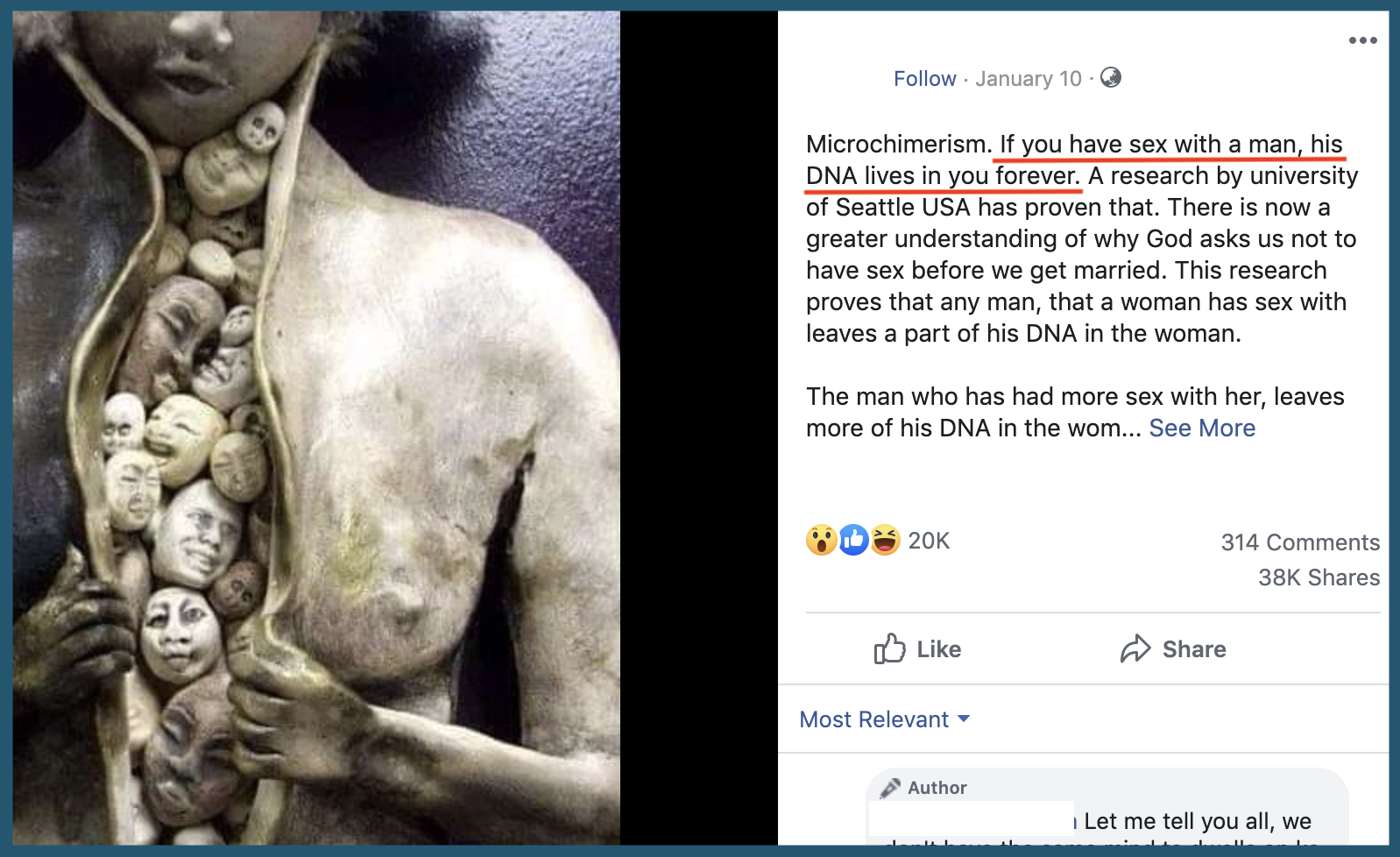A two-month-old Facebook (FB) post that erroneously claims engaging in sexual intercourse makes the deoxyribonucleic acid (DNA) of a man “live” in a woman’s body “forever,” along with other related falsehoods, is continuing to get traction on social media.
On Jan. 10, a netizen published on FB a photo of a sculpture by mixed media artist Kim Reyes. The photo, which was originally uploaded in a 2007 blog post on an art exhibit where Reyes’ piece was displayed, features a female torso cut in half that reveals a number of human faces inside it.
The image was accompanied with a long caption that warned women of microchimerism — scientifically defined as the “presence of cells from one individual in another genetically distinct individual” — which the post claimed to be the “true consequence” of sexual intercourse.
The post, which cited a study by a so-called “University of Seattle,” made seven claims, all of which pivot around the premise that a man’s cells and DNA remain inside the woman’s body after sex.
VERA Files Fact Check looked into each of them and found out only one is true, another is unproven, while the rest are downright false.
On the ‘University of Seattle’ study
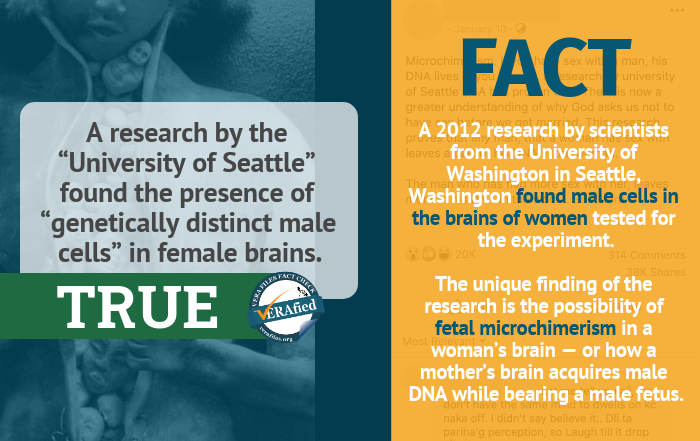
The closest research to what the post described was a 2012 study on male microchimerism conducted by scientists from the University of Washington in Seattle, Washington. The research, published in the journal PLOS ONE, found male cells in the brains of 37 out of 59 women tested for the experiment.
However, the study emphasized that microchimerism is a common phenomenon in the human body, and that the unique finding of the research is the possibility of fetal microchimerism in a woman’s brain — or how a mother’s brain acquires male DNA while bearing a male fetus.
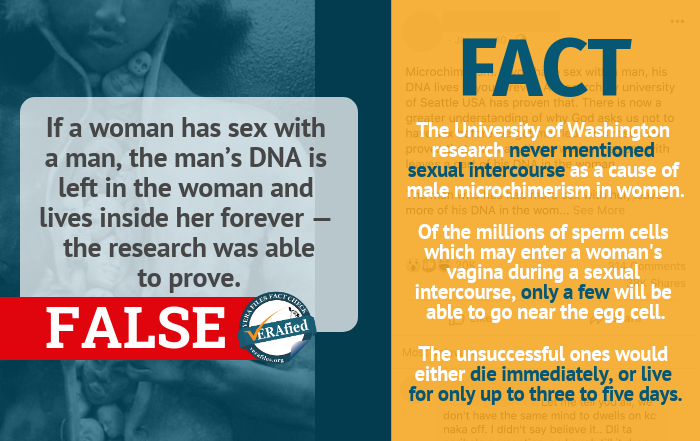
The University of Washington research never mentioned sexual intercourse as a cause of male microchimerism in women.
Rather, it said the male DNA found in females’ brains “most likely” came from “pregnancy with a male fetus.” Apart from pregnancy, it said other sources for male michrochimerism in a woman are a miscarriage, an abortion, a male twin, an older brother, or a blood transfusion with a man in the past.
A 2005 study on male microchimerism — published in The American Journal of Medicine and conducted by a different group of academics also from Seattle, Washington — hinted on sexual intercourse as a cause of male microchimerism after male DNA was found in blood cells of women who have not been pregnant with a male child. However, the research qualified this only as “another possibility that has not been investigated.”
A more recent study, done in 2015, suggested the same possibility of sexual intercourse as a cause of male microchimerism among young Danish girls who “may have had their sexual debut” but have no history of pregnancy.
The research, however, pertained to this as mere “speculation,” saying other sources of male microchimerism still “likely exist.”
Obstetrician and gynecologist Marinella Agnes Abat, a member of the Philippine Obstetrical and Gynecological Society, told VERA Files in an email interview that, of the 20 million to 200 million sperm cells which may enter a woman’s vagina during a sexual intercourse with a man, “only a few will make it to the fallopian tubes and go near the egg.”
The unsuccessful ones would either die immediately or live for only up to three to five days. These will then eventually die because of any of the following reasons:
- the acidic environment of the vagina would kill them;
- they would swim off in the wrong fallopian tube; or
- they would be killed by cells of the woman’s immune system.
Abat said once sperm cells die, they “lose the capacity to fertilize an egg,” and are then eliminated from the female body through menstruation or any vaginal secretions.
On a fetus carrying the ‘DNA’ of other men a woman has slept with
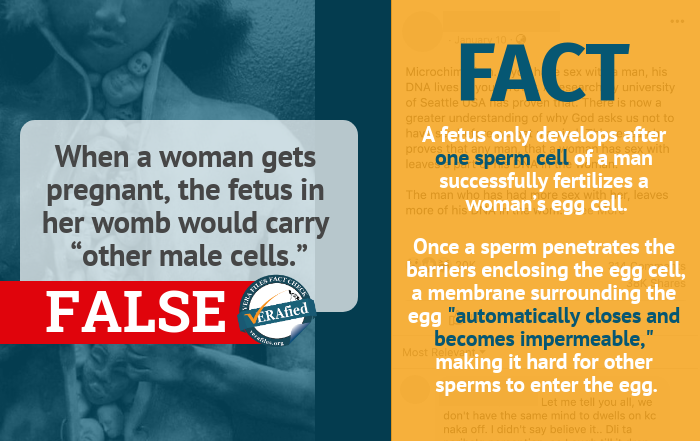
This is not true, as a fetus develops only after one sperm cell of a man successfully fertilizes a woman’s egg cell.
Abat said once a sperm penetrates the barriers enclosing the ovum (or the egg cell), a membrane surrounding the egg called the zona pellucida “automatically closes and becomes impermeable.” This makes it hard for other sperms to enter the egg. This activity is vital as it prevents polyspermy, or the “fertilization of an egg by more than one sperm.”
Polyspermy in humans is a very rare occurrence. So far, there are only two recorded cases of human polyspermy in the world, where two different sets of twins were successfully produced by the fusion of two sperm cells and one egg cell. These cases were studied in 2006 and 2019.
On a man leaving ‘more’ of his DNA in a woman he has sex with a number of times
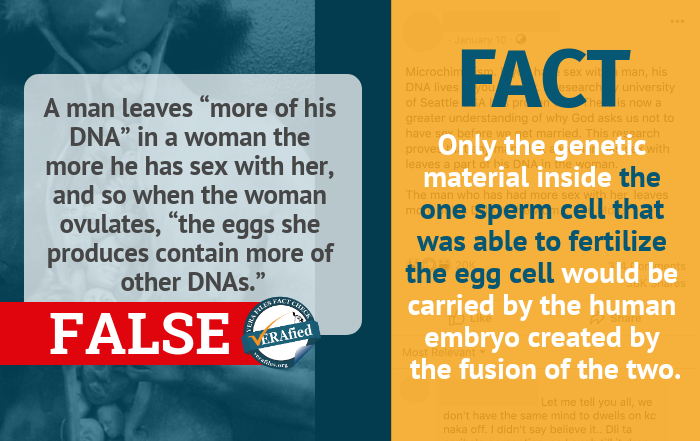
This claim is false, since only the genetic material inside the sperm cell that was able to fertilize the egg cell would be carried by the human embryo created by the fusion of the two.
The dead sperms, or those which were not able to penetrate the walls of the egg cell, lose their ability to fertilize and thus “cannot pass on its DNA” to the ovum, Abat said. She added that it is only through fertilization — or the “physical fusion of the egg and the sperm” — that a transfer of genetic materials could happen.
On the activities of sperm cells once they enter a woman’s body
![Claim 5: When a sperm cell enters a woman, “it swims until it hits a wall, and then seeps into [her] flesh.”](https://verafiles.org/wp-content/uploads/9115/84/20200313-sex-dna-claim5.png)
This is false. Abat said a human sperm cell is “genetically designed” to fuse with a human egg cell only. “It has no special powers to drill holes through thick walls of the vagina, cervix, or uterus,” making it “quite impossible” for sperm cells to “seep” into a woman’s flesh.
![Claim 6: If a sperm cell enters a woman through the mouth, it gets into her “nasal areas, behind [her] eyes, and even [her] inner ear,” before it enters her “bloodstream and collects in [her] brain and spine.”](https://verafiles.org/wp-content/uploads/4815/84/20200313-sex-dna-claim6.png)
Just as how unsuccessful sperm cells die due to the acidic environment of the vagina, sperms which enter the female human body through the mouth are also “very unlikely to survive beyond a few minutes” as enzymes present in the saliva have the capability to kill them, Abat said.
She added that “dead sperm cells cannot possibly travel beyond the oral cavity,” and even if they did, the microenvironment of the eyes, ears, nose, brain, and spine would not allow sperms to survive through them.
On the changing of a woman’s DNA
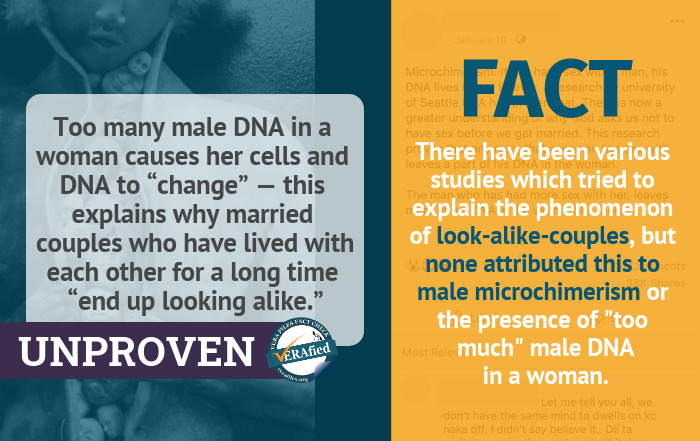
There have been various studies which tried to explain the phenomenon of look-alike-couples, but none attributed this to male microchimerism or the presence of “too much” male DNA in a woman, which supposedly causes a woman’s cells and DNA to change.
A study conducted in 1987 by the University of Michigan discovered that couples who have been together for at least 25 years develop significant physical similarity, the degree of which was “associated” with “greater reported marital happiness.”
Another study, published in 2010 by the Personality and Social Psychology Bulletin, found out that a person deems another person whose face resembles their own or their opposite-sex parent’s face more sexually attractive than those who display no resemblance to them or their parents.
Lastly, a 2018 study by academics from the City University of Hong Kong and the Chinese University of Hong Kong was able to conclude that “higher similarity in the perceived personality” of a couple influences their facial resemblance and relationship quality.
The netizen’s viral FB post, which has around 20,600 reactions and was already shared more than 38,300 times, is still making rounds on social media as the world continues to celebrate March as the Women’s History Month.
Online articles with claims similar to that of the netizen’s FB post were already previously debunked by a number of media organizations which do fact checking, namely, Snopes in June 2017, the Agence France-Presse in January 2019, and Africa Check in September 2019.
Sources
Tammyvitale.com, Kim Reyes’ Self Discovery, April 12, 2007
Tammyvitale.com, ArtoMatic: Kim Reyes and Brenda Sylvia, April 12, 2007
Shrivastava, S., Naik, R., Suryawanshi, H., & Gupta, N. (2019). Microchimerism: A new concept. Journal of Oral and Maxillofacial Pathology, 23(2). doi:10.4103/jomfp.JOMFP_85_17
Chan, W.F.N., Gurnot, C., Montine, T.J., Sonnen, J.A., Guthrie, K.A., & Nelson, J.L. (2012). Male Microchimerism in the Human Female Brain. PLOS ONE, 7(9): e45592. doi:10.1371/journal.pone.0045592
Yan, Z., Lambert, N.C., Guthrie, K.A., Porter, A.J., Loubiere, L.S., Madeleine, M.M., Stevens, A.M., Hermes, H.M., & Nelson, J.L. (2005). Male microchimerism in women without sons: quantitative assessment and correlation with pregnancy history. The American Journal of Medicine, 118(8): 899-906. doi:10.1016/j.amjmed.2005.03.037
Müller, A.C., Jakobsen, M.A., Barington, T., Vaag, A.A., Grunnet, L.G., Olsen, S.F., & Kamper-Jørgensend, M. (2015). Microchimerism of male origin in a cohort of Danish girls. Chimerism, 6(4): 65–71. doi:10.1080/19381956.2016.1218583
Souter, V.L., Parisi, M.A., Nyholt, D.R., Kapur, R.P., Henders, A.K., Opheim, K.E., Gunther, D.F., Mitchell, M.E., Glass, I.A., & Montgomery, G.W. (2006). A case of true hermaphroditism reveals an unusual mechanism of twinning. Human Genetics, 121: 179–185. Retrieved from https://link.springer.com/article/10.1007/s00439-006-0279-x
Gabbett, M.T., Laporte, J., Sekar, R., Nandini, A., et al. (2019). Molecular Support for Heterogonesis Resulting in Sesquizygotic Twinning. The New England Journal of Medicine, 380:842-849. doi:10.1056/NEJMoa1701313
Zajonc, R.B., Adelmann, P.K., Murphy, S.T., & Niedenthal, P.M. (1987). Convergence in the Physical Appearance of Spouses. Motivation and Emotion, 11(4): 335-346. Retrieved from https://annenberg.usc.edu/sites/default/files/2015/04/29/Convergence%20in%20the%20Physical%20Appearnce%20of%20Spouses.pdf
Fraley, R.C. & Marks M.J. (2010). Westermarck, Freud, and the Incest Taboo: Does Familial Resemblance Activate Sexual Attraction? Personality and Social Psychology Bulletin, 36(9): 1202–1212. doi:10.1177/0146167210377180
Wong, Y.K., Wong, W.W., Lui, K.F.H., & Wong, A.C.N. (2018). Revisiting facial resemblance in couples. PLOS ONE, 13(1): e0191456. doi:10.1371/journal.pone.0191456
Snopes, Do Women Retain DNA From Every Man They Have Ever Slept With?, June 26, 2017
Agence France-Presse, No, these scientific studies do not show that a man’s DNA stays inside a woman forever after sexual intercourse, Jan. 19, 2019
Africa Check, No evidence that sex leads to male DNA in women’s brains, Sept. 11, 2019
(Guided by the code of principles of the International Fact-Checking Network at Poynter, VERA Files tracks the false claims, flip-flops, misleading statements of public officials and figures, and debunks them with factual evidence. Find out more about this initiative and our methodology.)
